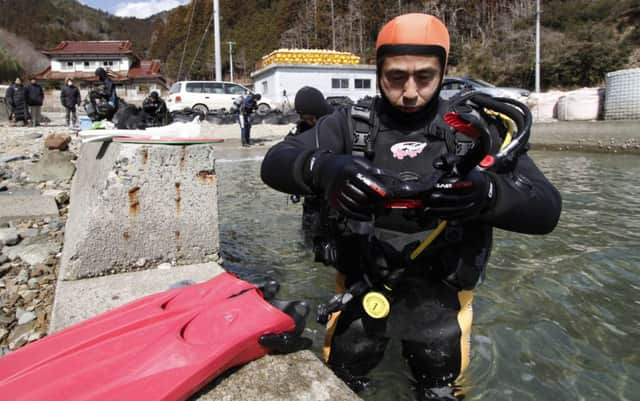Japan man learns scuba to try and find wife’s body


So determined is Mr Takamatsu, 57, that he is learning to scuba dive in the hope of recovering wife Yuko’s bones from the ocean depths.
It is estimated 15,884 people died in the disaster which began when a magnitude 9.0 quake struck at 2:46pm. At 3:21pm, his 47-year-old wife e-mailed: “Are you OK? I want to go home” That was the last he heard from her.
Advertisement
Hide AdAdvertisement
Hide AdOf 13 people who sought refuge on the roof of her two-storey office as the tsunami surged in, only one survived. Four bodies were found, while the other eight remain missing, presumed swept out to sea.
“She wrote, ‘I want to go home’,” Mr Takamatsu said. “Because I know she feels that way, I want to look for her myself rather than depend on others.”
Last Sunday, he and his instructor dived to nearly seven metres (23ft) in Takenoura Bay, Myagi prefecture, spending a little more than an hour underwater over the course of two dives.
It will take many more dives before Mr Takamatsu, who retired from working as a military aircraft mechanic and is now a bus driver, will be experienced enough to take part in searches.
“I haven’t quite been able to get used to the buoyancy while diving,” he said. “I need to get better, to find my wife.”
His diving instructor, Masayoshi Takahashi, conducts searches underwater with other volunteers at least twice a month. They still find belongings and, occasionally, bones.
Mr Takamatsu is not asking for much, just something that would bring her home. “Of course, I hope her body would show up,” he said. “I suppose it would be her remains by now. I hope I could find something.”
Yesterday Japan’s premier Shinzo Abe pledged to boost rebuilding efforts as Japan continues to struggle to rebuild towns and villages and clean up radiation from the meltdowns at the Fukushima Dai-ichi plant.
Advertisement
Hide AdAdvertisement
Hide AdShortages of skilled workers and materials are delaying the work. Japan has earmarked 25 trillion yen (£150 billion) for reconstruction.
But three years after the disaster, nearly 270,000 people remain displaced, including many from Fukushima prefecture who may never be able to return home due to radioactive contamination. Yesterday, during a ceremony in Tokyo, officials and representatives of the survivors held a minute’s silence to mark the moment the quake – the strongest recorded in Japanese history – struck off the north-east coast.
Mr Abe has visited disaster-hit areas regularly since taking office in late 2012, and said yesterday he has seen signs of progress. Farming and fishing had resumed in some areas, and some people have moved to public housing from shelters.
“We must further speed up the reconstruction so that everyone affected by the disasters can return to ordinary life as soon as possible,” added Mr Abe.
In Fukushima, reconstruction has lagged behind other areas because of the nuclear disaster.
Several towns are still off-limits due to high radiation.
The plant has stabilised substantially, but is still plagued by leaks of radioactive water and other mishaps. The leaks are hampering Fukushima’s decommissioning, which is expected to take 40 years to complete.